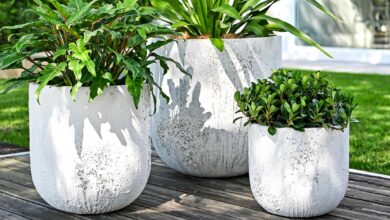
The Best Plants To Grow at Home: Your Guide
Having plants in your home can make for a healthier, more inviting living environment. Not only do they increase the oxygen in the air, but they can also provide a sense of comfort and improve your mood. Plants can also have various health benefits, such as improving mood and reducing stress.
These days, many people are looking to house plants more than ever to add a little life to their homes. When choosing plants to grow at home, there is something to fit everyone’s style and ability level.
We go over the best plant choices in our guide below.
Table of Contents
Aloe
If you’ve ever had a sunburn, you’ve probably lathered some aloe on it to soothe your skin. This sap comes from the aloe plant, and you can grow it in your own home.
This plant is as helpful as it is pretty to look at. Aloe is a succulent and doesn’t need much water. It does best when in indirect sunlight, especially in a cooler place.
You can use the leaves to help with any skin ailments. If you choose to cut them to access the aloe sap, remove only a leaf or two at a time.
Cast Iron Plant
As its name suggests, this is one of the most low-maintenance plants around. A cast iron plant can last in even the most challenging of climates. It doesn’t need much light to grow and does okay in shadier spaces.
The leaves of this plant can get up to two feet long and end at a point like a sword. If you want to grow this plant inside, it can flower.
Holiday Cactus
This cactus looks great and does best if you ignore it. It does well in low light but will give you bright flowers if it’s put in bright sunlight.
You can make this plant live up to its name by forcing it to bloom around December. To do this, keep the holiday cactus in total darkness for twelve hours a day starting in the middle of October. If you can’t make it dark, keep the plant by a chilly window once November hits.
Jade Plant
If you are looking for cool plants to grow, look no further than the jade plant. This popular indoor plant grows striking glossy leaves.
You need to make sure your jade plants get a lot of sunlight to grow. Keep it in the sunniest spot in your house.
Watering your jade plant takes a little patience. To avoid rotting roots or dropped leaves, you’ll need to keep it watered the right amount. Dry the soil out completely before watering again for the ideal moisture level.
Snake Plant
Another low-maintenance house plant to try out is the snake plant. These are some of the best plants for low light. You only need to water a snake plant a few times in the winter months, especially if you have a humid home.
The leaves are sharp and can grow very tall in the right conditions. You will also see a wide color variation with this type of houseplants.
Peace Lily
The strikingly long, white flowers on a peace lily are hard to ignore. You’ll find these plants in many homes and offices. Beauty isn’t the only thing they bring to a space; they are also some of the best plants for clean air.
These indoor plants do best with indirect sunlight. The more light they get, the more flowers they will bloom.
Make sure you take care not to overwater your peace lily. Overwatering this plant is a big reason they won’t make it. Avoid this by watering your plant by touch rather than on a schedule.
Feel the soil of your peace lily each week. If it feels dry, you can water it. Don’t add any more water if there is any dampness to the soil.
Pothos
These plants look best in a hanging planter. Their trailing leaves make for a statement piece in your home.
Make sure to dry out the soil of your pothos before adding more water to the pot. Don’t let it go too far between watering, or the leaves will wilt and die.
This plant is great in an office because it does so well in artificial light. If you want to multiply these plants, you can do so by adding a cutting to water.
Prayer Plant
You’ll love the colorful leaves of this tropical plant. The leaves lay flat in the daytime and fold up at night, hence its name. Even better is that the prayer plant does well in many different conditions.
Keep your prayer plant warm and in a sunny place to keep it thriving. It doesn’t grow very fast and doesn’t get much taller than a foot.
This type of plant can attract mealybugs and spider mites. Check the leaves for a white powder, which is the sign of an infestation. You can use neem oil on the leaves if an infestation does happen.
Monstera
The monstera plant has taken the decor world by storm in the last few years. The broad leaves make a statement in any household. It’s also referred to as the Swiss cheese plant because of the distinctive holes in the leaves.
The monstera plant originates in tropical regions, so it needs indirect light to grow. They also like temperatures that are 60 degrees and above.
When it comes time to water the monstera, only do so when the soil is totally dry. You can mist the plant each week to keep it happy. If you have to leave your plant for a trip, give it a good drink before you need to go.
Chrysalidocarpus
The large, tall leaves will be hard to ignore on this palm tree. You won’t be able to miss this plant as it can grow to be up to eight feet tall. The thin, fern-like leaves are full lush.
When planting your chrysalidocarpus, make sure to use a high-quality soil mix. A layer of small stones at the bottom of the planter will help encourage proper drainage.
Your plant will do best by a window where it can get some direct sunlight. A good trick is to place a western-facing window that receives some light but not enough to damage the leaves.
To keep this plant alive, mist it with water every few days to mimic its natural environment. Let the soil dry out before adding more water.
You don’t need to water your plant as much in the winter months. Make sure to increase the watering to every three days once the weather warms up again.
Chinese Money Plant
You’ll love the beautiful round leaves found on this succulent. Native to China, you’d find this plant growing by the base of the Himalayan mountains.
These plants love indirect sunlight. If you want to keep your plant looking its best, rotate it so that the sides each get an equal amount of sun.
You don’t need to worry about daily watering with this plant. Let your money plant get almost dry before adding more water to the soil. You can tell when your plant needs more water when the leaves get droopy.
Most homes are humid enough to support the growth of these plants. For a very healthy plant, add fertilizer every month during the spring and summer. It’s also a good time to repot your plant to refresh the soil and increase the pot size.
Passion Flower
Walk on the wild side by choosing this vine to grow in your home. Growing a vine inside is easy! All you need is something that they can climb, and they will do a great job indoors.
These plants flower without much effort. The bright purple flowers will make a fun addition to any room.
Make sure your passion flower gets at least four hours of direct light each day. Consider getting a grow light to keep your passion flower strong in the winter months.
To get these plants to flower, they need a cooling period in the winter months. They do well in warm weather during the other months of the year.
The soil for this plant needs to stay quite damp. Don’t drown your soil, but make sure it doesn’t dry out. If you turn the heat up in the winter, add a humidifier near this plant to keep it from getting too dry.
These plants have no problem flowering! In the spring, make sure to cut away damaged leaves. This practice will help encourage new, healthier growth.
Apricots
You don’t have to stick to plants that just look pretty; you can also grow fruit inside! Apricot trees are easy plants to grow if you have the sun, soil, and space in your home.
Start by planting your apricot seeds in a large pot in high-quality soil. The planter should stay near a south-facing window for good sun where it can have a full day’s worth of sunlight.
Add fertilizer to your apricot tree at least once a year to keep it healthy. The soil should stay damp and never get too dry. It will take about two years before your tree will grow big enough to produce fruit.
Salad Burnet
This perennial, part of the rose family, is excellent for food. People have used this plant since the bubonic plague to help stop bleeding.
You’ll find rounded, toothy leaves in a dense clump. Adding this to a meal will produce a light, cucumber-like flavor.
You’ll want to keep this plant in in-direct sunlight. It does well in dry soil, but keeping it semi-moist will help it grow strong. It also does well in high heat.
Spanish Lavender
For a pop of color, give a Spanish lavender plant a try. Lavender has a long history of providing stress relief and gives off a delicious scent.
For success with growing lavender, you’ll need hot, bright sunshine. This is the key to getting it to bloom the flowers that it’s known for. Growing lights are a significant investment if you want to ensure the growth of these flowers.
A tip to growing lavender is to put crushed eggshells in the soil. This will keep the pH balanced.
Don’t add too much water to your lavender. Add enough water for the plant to feel damp but not soaking wet.
Herbs
Are you looking to add some fresh produce to your countertop? If so, try growing herbs in your home. Many herbs are easy to grow and do well with only a little bit of upkeep.
Herbs love the sun and should be in sunlight for at least six hours a day. Try a south-facing window for the brightest light. Don’t worry if the growth slows down when the light is less in the winter months.
All your herbs need is a bit of water to stay alive. Any more than that, and they could get too soaked and stop growing. You can tell if you have overwatered your herbs if the leaves wilt and get yellow.
When it comes time to use your herbs, make sure to take one or two sprigs at a time. You can use kitchen scissors or pinch the sprig off with your fingers.
Test Out Your Green Thumb With Any of These Plants to Grow at Home
Growing plants at home offer many advantages, both indoors and outdoors. Plants add a beautiful and relaxing touch of color to your space. No matter where they live, anyone can find plants to grow at home and reap the benefits that they give.
Are you looking for more home tips and tricks? If so, check out our other lifestyle blogs for inspiration today!








